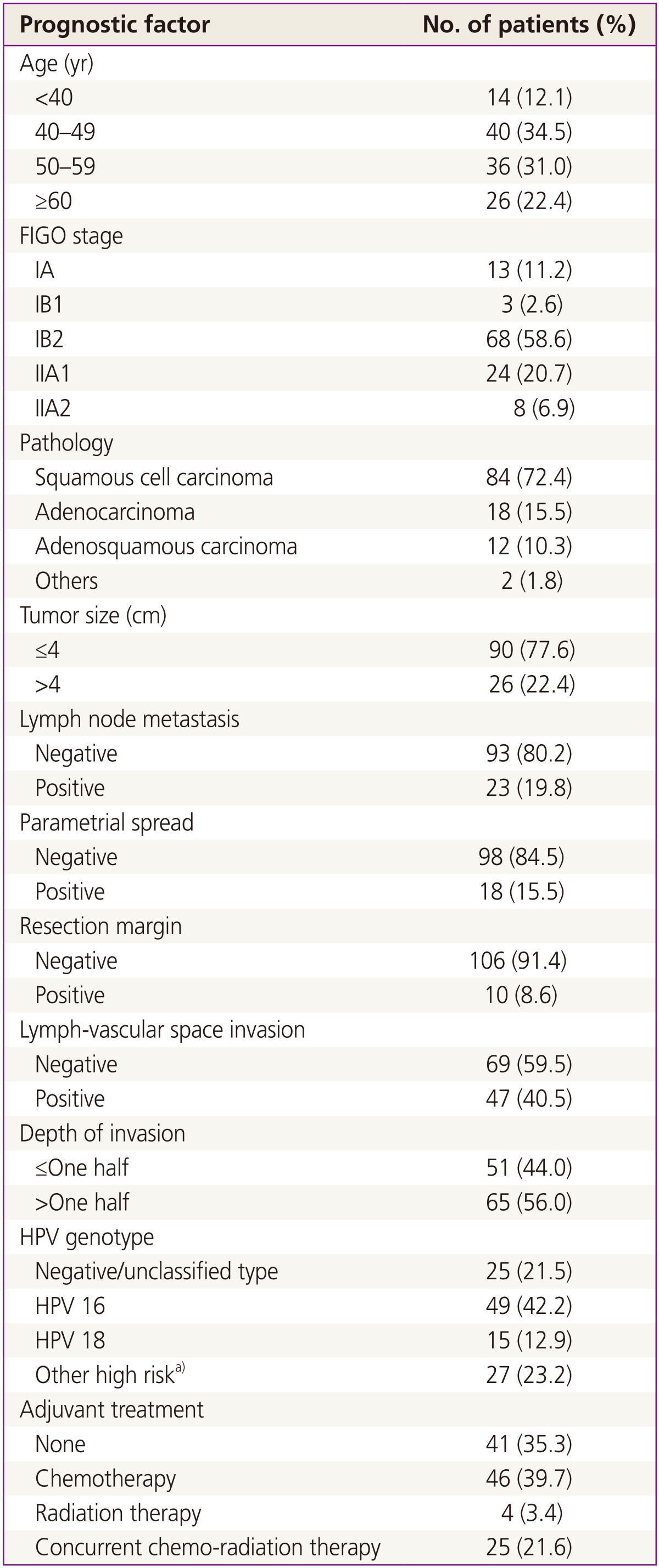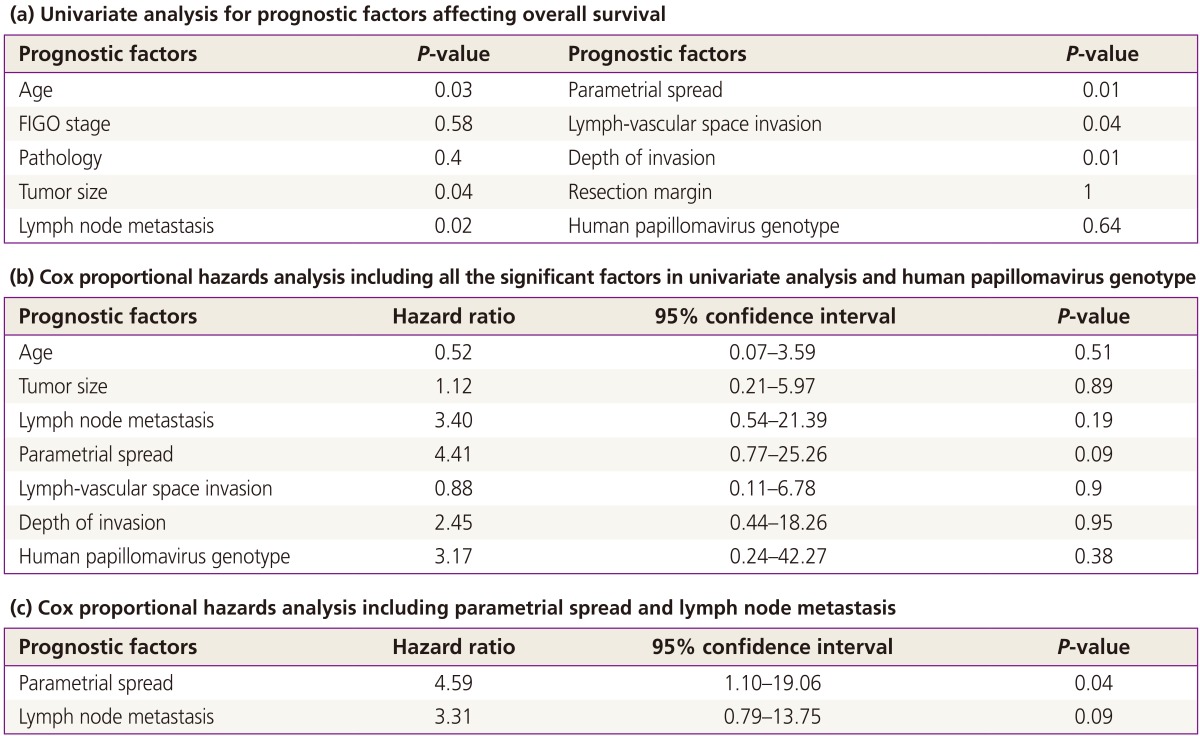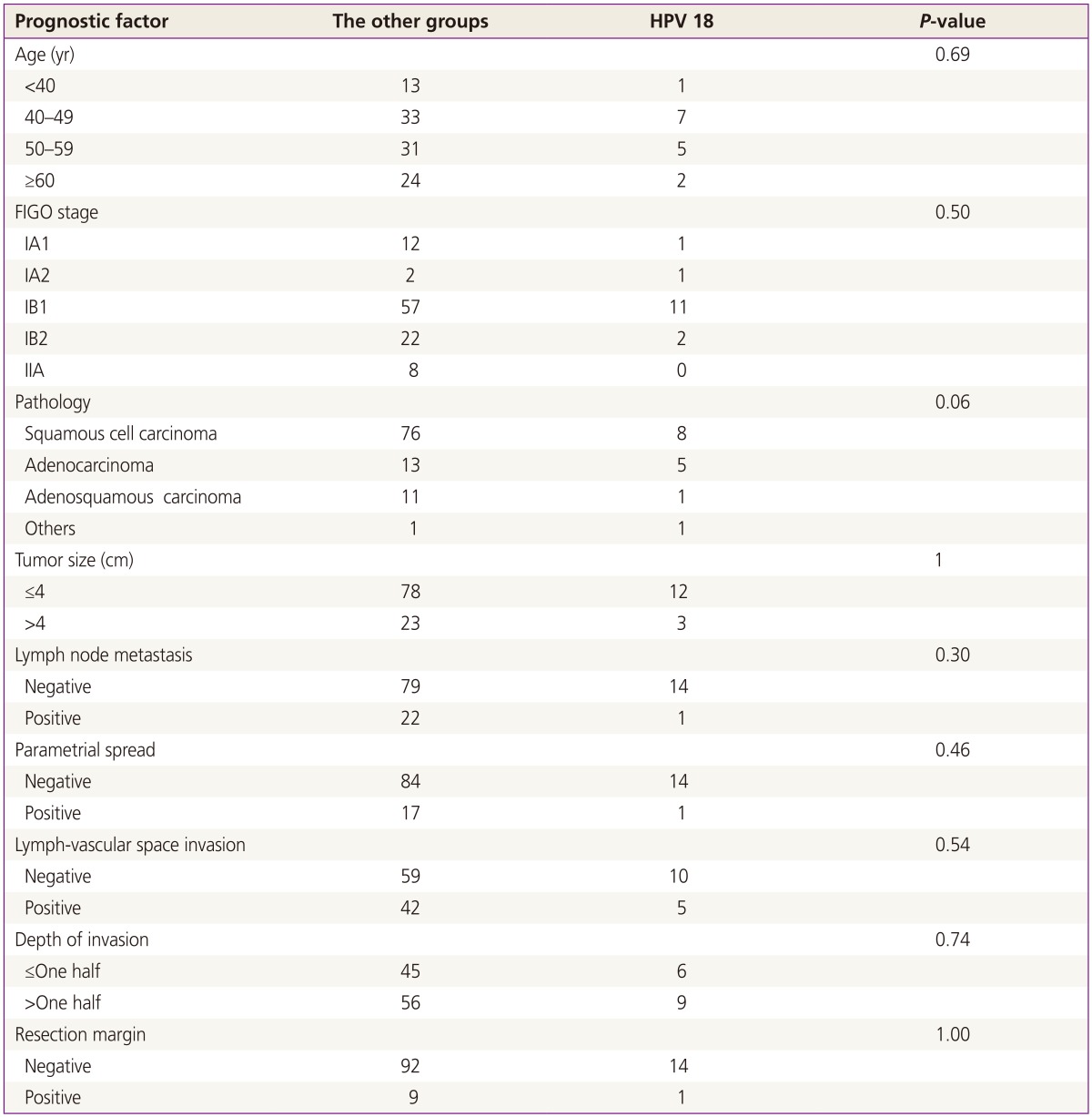Human papillomavirus 18 as a poor prognostic factor in stage I-IIA cervical cancer following primary surgical treatment
Article information
Abstract
Objective
This study evaluates the effect of the specific human papillomavirus (HPV) genotype as a prognostic factor in stage I-IIA cervical cancer patients following primary surgical treatment.
Methods
The medical records of 116 cervical cancer patients treated with primary surgical treatment were reviewed. The HPV genotypes were categorized into following groups: negative and unclassified, HPV 16, HPV 18, and other high risk (HPV 31, 33, 35, 45, 51, 52, 56, and 58).
Results
Among the HPV genotypes, HPV 16 predominated (40.52%), followed by intermediate risk and unclassified (25%), HPV 18, 45, and 56 (17.24%) and negative (17.24%). In univariate analysis, HPV genotypes (P=0.03), parametrial spread (P=0.02), depth of invasion (DOI) (P<0.01) and lymph-vascular space invasion (P=0.02) were significantly associated with progression free survival (PFS). In multivariate analysis, HPV 18 (hazard ratio [HR], 5.2; 95% confidence interval [CI], 1.29 to 20.90; P=0.02) and ≥one half of DOI (HR, 5.4; 95% CI, 1.08 to 27.31; P=0.04) were significantly associated with PFS. HPV genotypes are not significantly associated with overall survival.
Conclusion
HPV 18 was a poor prognostic factor for the PFS in stage I-IIA cervical cancer patients following primary surgical treatment. Careful long-term observation and regular exams are recommended for cervical cancer patients with HPV 18 compared to those with other HPV genotypes.
Introduction
Although the incidence of the cervical cancer is steadily decreasing, it still is the third most common malignancy in females worldwide [1,2]. Reflecting this decline, cervical cancer was the most common cancer in women during the 1980s in Korea, but the seventh most common cancer (3,733 cases, 4% of all cancers in females) in 2009 [3]. Clinicopathologic factors for cervical cancer including International Federation of Gynecology and Obstetrics (FIGO) stage, lymph node metastasis (LNM), parametrial spread (PM), nonsquamous histology, lymph-vascular space invasion (LVSI), and depth of invasion (DOI) are associated with the prognosis. Human papillomavirus (HPV) is a major causal factor in the development of cervical cancer. The HPV DNA detection rates approach 95% to 100% in cervical carcinoma tissue with adequately sensitive methods [4,5,6,7]. The etiological link between HPV genotypes and cervical cancer is well established. Specific genotypes are responsible for the oncogenic potency of HPV, and each HPV genotype results in a different prognosis. Therefore, the precise genotyping of HPV is clinically important. Recent research focuses on specific HPV genotypes as a prognostic factor in cervical cancer. Several studies find that HPV 18 positivity is associated with poorer prognosis [8,9,10,11,12,13], whereas others find that HPV 16 positivity, rather than HPV 18 positivity, is a poor prognostic factor [14]. In addition, HPV 58 related and HPV 31 related types are associated with better prognosis [15] and these types also predicted better survival outcome [16]. In contrast, other researchers found no prognostic value for HPV status or HPV genotype [5,17,18]. The role of HPV genotype as a prognostic factor for the early stage cervical cancer is not clear and the usefulness of specific genotypes in predicting the prognosis of early stage cervical cancer patients treated with primary surgical treatment remains questionable. Therefore, the effect of the specific HPV genotype on prognosis in stage I-IIA cervical cancer patients who underwent primary surgical treatment was evaluated in our study.
Materials and methods
1. Case selection
One hundred and thirty-two women were diagnosed with FIGO stage I-IIA cervical cancer and primarily treated with surgery in the Department of Obstetrics and Gynecology, Gachon University Gil Medical Center from January 2007 to December 2010. Of 132 patients, 16 patients who did not take HPV genotype testing before the surgery were excluded. One hundred and sixteen women who underwent HPV genotype testing at the time of diagnosis were considered eligible for our study. Primary surgery methods for the 132 women were simple hysterectomy and radical hysterectomy including retroperitoneal lymphadenectomy. The HPV genotypes were categorized into following four groups: negative and unclassified, HPV 16, HPV 18, and other high risk (HPV 31, 33, 35, 45, 51, 52, 56 and 58).
Post-treatment surveillance consisted of visits every three months for the first two years, every six months between years three and five, and annually after five years. Each visit consisted of a clinical history, physical and pelvic examinations, Pap smear, and serum tumor markers. Annual chest X-ray was recommended in asymptomatic patients, while computed tomography or magnetic resonance imaging scans were performed for those at high risk or when clinically indicated.
Evaluation of the progression after the first-line therapy followed the guidelines of the Gynecology Cancer Intergroup [19]. The results of progression were recorded based on either the objective RECIST criteria or the CA-125 criteria [19,20]. When progression was documented by both, the date of progression represented the date of the earlier of the two events. Progression free survival (PFS) was defined the interval between the date of primary surgery and the date of recurrence.
2. Human papillomavirus DNA chip test
Cervical cells for HPV genotype testing were sampled before starting the treatment. HPV genotypes were identified with a commercially available HPV-DNA chip purchased from the Ahn-Gook Pharmaceutical Corporation (Seoul, Korea). The HPV-DNA chip contains 32 type-specific probes: 18 kinds of the high-risk types (HPV 16, 18, 26, 31, 33, 35, 39, 45, 51, 52, 56, 58, 59, 66, 68, 69, 70, and 73) and 14 kinds of the low-risk types (HPV 6, 11, 32, 34, 40, 42, 43, 44, 53, 54, 55, 57, 61, and 62).
3. Statistical analysis
The statistical analyses were performed with IBM SPSS ver. 21.0 (IBM Corp., Armonk, NY, USA). The associations between various clinicopathologic factors and HPV genotype were analyzed with Pearson's chi-square test or Fisher's exact test. The Kaplan-Meier method with the log-rank test and multivariate Cox proportional hazard analysis with hazard ratio (HR) and 95% confidence interval (CI) were used to examine the association between HPV genotype and the survival outcome. Null hypotheses of no difference were rejected if P-values were less than 0.05, or equivalently, if the 95% CIs of risk point estimates excluded 1.
4. Ethics
The institutional review board of Gachon University Gil Medical Center, Korea, approved the study (GBIRB2014-32). The informed consent requirement was waived because the current study was performed by a retrospective review.
Results
1. Patient characteristics
Age was categorized into four roughly equal strata: <40 (14 patients, 12.1%), 40 to 49 (40 patients, 34.5%), 50 to 59 (36 patients, 31.0%), and ≥60 (26 patients, 22.4%). The pathologic types were identified as follows: squamous cell carcinoma (84 cases, 73.9%), adenocarcinoma (18 cases, 14.4%), adenosquamous carcinoma (12 cases, 10.3%), and others (2 cases, 1.7%). With regard to the FIGO stage, stage IB2 was the most common with 68 cases (58.6%), and 13 cases were IA (11.2%), three cases were IBI (2.6%), 24 cases were IIA1 (20.7%), and eight cases were IIA2 (6.9%). Eighteen cases (15.5%) were positive in PM, 10 cases (8.6%) had positive resection margin (RM), and 47 cases (40.5%) had positive LVSI. In our study we divided the DOI into two groups: ≤one half group included 51 cases (44.0%) and >one half group was 65 cases (56.0%). There were 26 cases (22.4%) patients with tumor size larger than the maximum diameter of 4 cm, and 90 patients' tumors (77.6%) were less than the maximum diameter of 4 cm.
HPV 16 was the most prevalent genotype (49 cases, 42.2%), followed by other high risk types (27 cases, 23.2%), negative and unclassified (25 cases, 21.5%) and HPV 18 (15 cases, 12.9%). Adjuvant treatment was performed as follows: 41 patients (none), 46 patients (chemotherapy), four patients (radiation therapy), and 25 patients (concurrent chemo-radiation therapy) (Table 1).
2. Univariate and multivariate analyses of clinicopathologic factors on progression free survival and overall survival
The median duration of observation of surviving patients was 51 months (range, 10 to 60 months). Among clinicopathologic factors, PM, LVSI, DOI, and HPV genotype were significantly associated with PFS by univariate analysis (Fig. 1), while age, FIGO stage, pathology, tumor size, LNM, and RM were not. Based on the multivariate analysis, the risk of recurrence was 5.2 times higher in HPV 18 positive patients (HR, 5.2; 95% CI, 1.29 to 20.90; P=0.02) and 5.4 times higher in >one half of DOI (HR, 5.4; 95% CI, 1.08 to 27.31; P=0.04) (Table 2). In univariate analysis, age, tumor size, LNM, PM, LVSI, and DOI were significantly associated with overall survival (OS), but FIGO stage, pathology and HPV genotype were not significantly associated with OS. No clinicopathologic factor was significantly associated with OS in multivariate analysis. Of note, HPV genotype was not significantly associated with OS in either univariate analysis or multivariate analysis. We therefore performed multivariate analysis for PM and LNM, which are strong risk factors for survival of cervical cancer patients. The results showed that PM was significantly associated with OS (Table 3).

Univariate analyses of clinicopathologic factors on progression free survival (PFS). Of the clinicopathologic factors, (A) parametrial spread (PM), (B) depth of invasion (DOI), (C) lymph-vascular space invasion (LVSI), and (D) human papillomavirus (HPV) genotype were significantly associated with PFS.
3. Comparison of clinicopathologic factors of patients with human papillomavirus 18 and all other patients
Age, FIGO stage, pathology, tumor size, LNM, PM, LVSI, DOI, and RM did not differ significantly between groups. We compared the clinicopathologic factors of patients with human papillomavirus 18 and all other patients. Age, FIGO stage, pathology, tumor size, LNM, PM, LVSI, DOI, and RM did not differ significantly between groups (Table 4).
Discussion
Our study evaluated the prognostic value of the HPV genotype for the survival of women with FIGO stage I-IIA cervical cancer following primary surgical treatment. In fact, comparisons among studies of HPV genotype and the risk of recurrence of cervical cancer are difficult because of different study designs, different grouping of HPV genotype, no homogeneity of the sample and the outcome procedures among the studies.
Different researchers categorized HPV genotypes into different groups, and the studies were conducted to evaluate significant associations between HPV genotype and PFS and OS. Burger et al. [10] classified HPV genotypes into four groups (HPV 16, HPV 18, other and undetected), as did Lombard et al. [11] (HPV 16, HPV 18, intermediate risk and undetermined). Rose et al. [8] and Pilch [21] classified HPV genotypes into two groups (HPV 16 positivity and HPV 18 positivity). In our study, HPV genotypes were classified into four groups as follows: negative and unclassified, HPV 16, HPV 18, and other high risk. Since many studies classified HPV genotype differently without an established standard classification, comparison among studies is not feasible.
The effect of HPV genotype on prognosis of early stage cervical cancer remains controversial [8,10,11,12,14]. Burger et al. [10] identified HPV 18 positivity as an independent poor prognostic factor in a subgroup of 171 cervical cancer patients treated with radical hysterectomy and pelvic lymph node dissection. Lombard et al. [11] confirmed that patients with HPV 18 associated tumors had a relative risk of death 2.4 times greater (95% CI, 1.29 to 4.59) than that of patients with HPV 16. In another study, HPV 18 positivity was associated with double the risk of death in cervical cancer patients with tumors containing HPV DNA. This association was limited entirely to the patients with early stage cervical cancer [12].
In contrast, Pilch et al. [21] found that HPV 16 positivity, but not HPV 18 positivity, was a poor prognostic factor in 204 patients with radical hysterectomy and pelvic lymph node dissection. Viladiu et al. [14] reported that clinical stage is the only independent prognostic factor, and that HPV 16 E7 antibody predicts mortality in patients with stage I-II cervical cancer only. In addition, Bachtiary et al. [22], in a study of 106 cervical cancer patients receiving radiation therapy, found that multiple-type HPV was an independent poor prognostic factor.
In our study, HPV 18 positivity and DOI were associated with PFS while other factors were not, in both univariate analysis and multivariate analysis. HPV 18 positivity was associated with an approximately 5.2 fold increase in the risk of recurrence. For OS, we performed multivariate analysis for the factors that were significant in the univariate analysis, adding HPV genotypes. However, we found no significant associations in multivariate analysis. The lack of significant associations is likely due to the small study size and the short surveillance period. The number of events was few (18 recurrences and eight deaths). Secondly, we gave adjuvant treatment to patients at risk of recurrence after primary surgical treatment. It is likely that adjuvant treatment reduced the risk of recurrence and offset the risk of factors interrelated in univariate analysis. So we conducted the multivariate analysis for PM and LNM that are high risk factors in survival of cervical cancer patients, and found that only PM was significantly associated with OS.
Based on the PFS results, we divided patients into two groups, HPV 18 positive patients and patients with the other genotypes, to identify whether there is a significant difference in clinicopathologic factors between groups. However, we found no significant difference with respect to age, FIGO stage, pathology, tumor size, LNM, PM, LVSI, DOI, and RM. A study that divided patients into two groups just like our study, HPV 18 positive patients and all others, found that age, FIGO stage, tumor size, LNM, and PM were unrelated to HPV 18 positivity, results that correspond to our study. However, unlike the current study, HPV 18 positivity was significantly more common in patients with adenocarcinoma (42.2%) and adenosquamous carcinoma (42.9%) than squamous cell carcinoma [23].
Our study has some limitations. First, as mentioned above, the study size was small, and the surveillance period was not long. Second, also as mentioned above, the influence of adjuvant treatment on OS was ignored during the progress of the study. According to an earlier study, HPV 18 associated cancers recur at higher rates regardless of adjuvant radiation therapy. The influence of adjuvant chemotherapy with radiation therapy needs further evaluation in this setting, as it may help overcome the adverse effect of HPV 18 [24]. Last, HPV genotype testing was not performed routinely at follow-up visits, so we could not evaluate the effect of residual HPV infection on prognosis. Therefore, we suggest that prospective studies with patients use standardized treatment protocols and standardized PCR techniques for HPV detection. Such a design can precisely address the prognostic relevance of HPV status and HPV genotype in cervical cancer patients.
In conclusion, our study shows that HPV genotype testing is important because of its independent prognostic value in early stage cervical cancer. Thus, cervical cancer patients with HPV 18 should be more carefully tracked and observed compared to those with other HPV genotypes.
Notes
No potential conflict of interest relevant to this article was reported.



